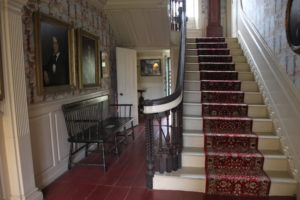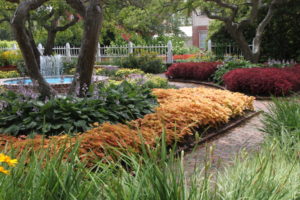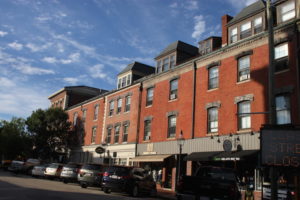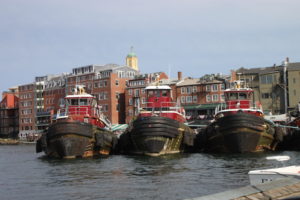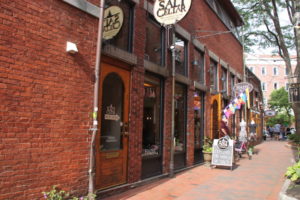During a day visit to Portsmouth, N.H., this July, my sister and I spent an enlightening two hours at the Strawbery Banke Museum, an outdoor facility right in the heart of town. But we wanted to see more of the city.
One of America’s oldest cities, dating from 1623, Portsmouth boasts other historical sites plus the modern appeal of a small still-active port town that also offers theater, galleries, restaurants, low-rise architecture and watery views.
The city sits near the mouth of the Piscataqua River and is the highlight of New Hampshire’s tiny coastline. We took an hourlong harbor cruise (following the river into the Atlantic past the Portsmouth Naval Shipyard — located in Maine, BTW), and we toured the John Paul Jones House (where the naval hero was a renter while overseeing ship construction on the river’s Badgers Island).
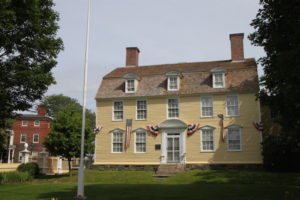
The John Paul Jones House, so named these days because the naval hero, John Paul Jones, was a boarder.
And we walked — a lot.
We walked through the riverfront Prescott Park to see its well-known gardens and wound up waltzing right onto the scene of the annual Prescott Park Arts Festival, glimpsing a “Mary Poppins” matinee production.
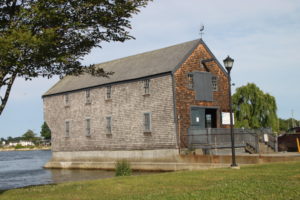
Sheafe Warehouse, dating from c. 1740, restored and moved to Prescott Park. It is used for art exhibits nowadays.
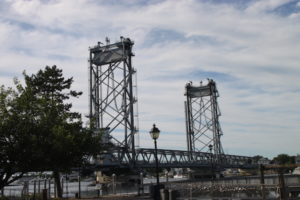
Memorial Bridge crossing the Piscataqua River from Portsmouth, N.H., to Maine, viewed from Prescott Park.
For nice late-day photos, we returned to the dock area and to the historic center on Market Square, both characterized by lots of 19th century red brick buildings. Portsmouth experienced four major fires in the early 1800s, but after the Great Portsmouth Fire of 1813, city fathers decreed that every new two-story or taller building in downtown Portsmouth be built of brick.
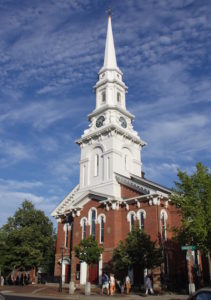
The North Congregational Church on Market Square in Portsmouth’s historic center. George Washington attended services at this site during his 1789 visit, but this is a later brick version of the church he visited.
The tavern where George Washington slept during a 1789 visit was lost in the 1813 fire. Most of the Strawbery Banke houses, the John Paul Jones House and a number of other historic buildings were survivors.
We also discovered Commercial Way, a narrow, blocklong pedestrian-only street in the historic center. Here, we shopped for souvenirs and gifts at the Salt Cellar, choosing several items of the pink Himalayan variety. Ever heard of a Himalayan soup salter? I have one now.
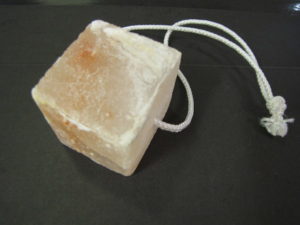
My new (and as-yet-unused) soup salter, a cube of Himalayan salt meant to be dipped into the pot (pasta water, soups, stews or chili) and dragged in circles for about 30 seconds to add “fantastic flavor.” It gets rinsed quickly thereafter.
We needed a dinner spot, not a hard thing to find in a city that boasts more restaurant seats than residents (population: roughly 21,000). But Cava, a tapas eatery, was right there on Commercial Way, so we entered not knowing the site was one of 19 rated by a Maine-based foodie pub as “worth the drive” to Portsmouth (19 is an odd number, right?).
The small servings allowed us to try a few dishes, for one of our best meals on a nine-day trip. We finished with churros plus the chocolate to dip them in, producing a display that inspired diners at the next table to ask what they were.
Churros are strips of fried dough dusted with sugar or cinnamon. Dipping them in chocolate makes them seem, well, less like fried dough.
In fact, they were a very satisfying topper for a day that started with an immersive trip into the past at Strawbery Banke Museum — the subject of this posting: https://besttripchoices.com/my-travel-corner/portsmouth-n-h-about-strawbery-banke/
In addition, for more about Portsmouth, we offer at BestTripChoices.com the following, under the headline: A place of Distinction
https://besttripchoices.com/us-cities/portsmouth-new-hampshire/
This blog and photos are by Nadine Godwin, BestTripChoices.com editorial director and contributor to the trade newspaper, Travel Weekly. She also is the author of “Travia: The Ultimate Book of Travel Trivia.”

